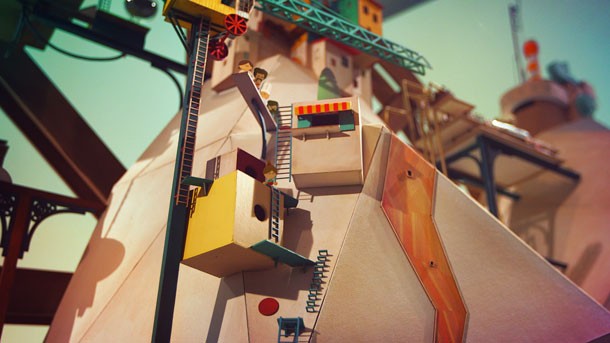Please support Game Informer. Print magazine subscriptions are less than $2 per issue
Lumino City Review

Lumino City is gorgeous. You could place a screenshot from the game next to an image from Laika Studios films like Coraline and ParaNorman and no one would question its place in the line-up. Playing with my young daughter prompted exaggerated, mouth-agape “Ooohs” and “Ahhs” as we moved from scene to scene, and I absolutely related to her excitement. Lumino City is meant to be more than just a beautiful series of images, but when it comes to puzzles, story, and characters, it plays things safe without offering quite the same inspiration as its visuals.
Part of what makes Lumino City so stunning is that all of the backgrounds (even the moving and rotating parts) were built by hand. Everything looks like you could reach out and feel the ridges on the cardboard, or tug at the yarn stringing everything together, because these structure actually exist in a studio space somewhere in Camberwell, London. The movements from scene to scene also showcase an expert understanding of the importance and use of excellent cinematography. I often moved from location to location just to see the camera pan around the structures.
Once you’re done gawking at the visuals, you can focus on the story and its characters. You are Lumi, the granddaughter of the local handyman. He gets kidnapped while you are making him some tea, and it becomes your task to track him down. The journey takes you to the top of Lumino City while meeting an assortment of characters and solving puzzles along the way.
Story is limited, as the goal of finding your grandpa never wanes, but some of the characters express interesting personalities. The guitarist with no pants and the helpful diner cook with a crush on Lumi both stand out as memorable, but the plot doesn’t expand until the game is over. Some backstory and an interesting environmental message appear as the credits roll, and I was disappointed these moments weren’t spread across the narrative. They would have added context during the playthrough, rather than making players assign significance retroactively.
Lumino City's puzzles are familiar to anyone who has played a point-and-click adventure. Certain objects collected in your inventory must be used to make it to new locations – like using lemons collected from a tree to create an electric current. You will also find yourself looking at a series of rotating wheels or switches, hitting on-screen buttons and performing trial-and-error tasks until something happens. The puzzles get especially tough near the end, but the novel hint system prevents you from ever getting entirely stuck.
At the beginning, your grandpa drops a 900 page book you carry with you throughout your journey. You can look at every single page, which reads like a mechanic’s manual, but the table of contents offers math equations for finding the specific page containing the solution to each puzzle. As long as you know your order of operations, you can find the solution to any puzzle in the game. The book is not required to solve any of the puzzles, and is meant to serve as an optional hint system. By the end, I was relying on the book too much, but I was happy it existed. I’d rather have an in-game approach to hints rather than resort to the Internet for help.
Ignoring the beautiful visuals (which you shouldn’t), Lumino City is an unspectacular point-and-click game. It hits the familiar notes of the genre without veering into the dangerous realm of frustration, but doesn’t experiment with structure in any meaningful ways. It toes the point-and-click line with its mechanics, characters, and story but its hand-crafted aesthetic is what elevates it into the realm of something special worth experiencing.














































